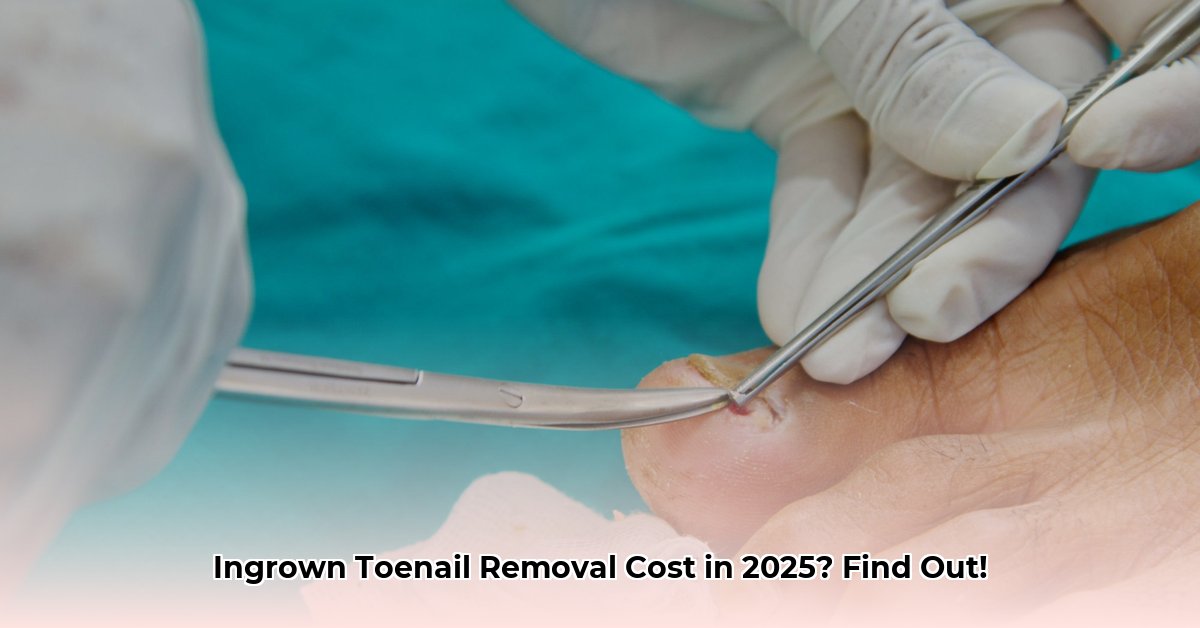Dealing with an ingrown toenail? That throbbing pain can sideline you. While home remedies sometimes work, professional care is often needed to prevent infection. This guide breaks down ingrown toenail removal costs in 2025, from at-home care to surgical procedures. Understanding these costs empowers you to make informed decisions about your treatment.
Understanding Ingrown Toenail Costs
The cost of ingrown toenail treatment varies widely, influenced by several factors. Let’s explore what can impact your expenses.
Factors Affecting Cost
Several factors can influence the price of ingrown toenail removal:
-
Procedure Type: A simple partial nail removal is less expensive than a total nail avulsion or a matrixectomy (permanent nail removal).
-
Severity: A minor ingrown toenail will likely cost less to treat than a severe, infected one.
-
Anesthesia: Local anesthesia adds to the overall cost.
-
Location: Costs tend to be higher in urban areas and major cities.
-
Facility: Hospitals generally charge more than clinics.
-
Doctor’s Expertise: A highly experienced podiatrist may charge more.
-
Insurance Coverage: Your out-of-pocket expenses depend on your insurance plan, including co-pays, deductibles, and coinsurance.
Cost Breakdown with Examples
Here’s a general idea of potential costs in 2025:
| Scenario | Estimated Cost Range |
|---|---|
| At-Home Care | $5 – $30 |
| Doctor’s Visit (without insurance) | $70 – $150 |
| Simple Removal (without insurance) | $200 – $500 |
| Partial Nail Avulsion (without insurance) | $250 – $500 |
| Total Nail Avulsion (without insurance) | $490 – $1,500 |
| Matrixectomy (without insurance) | $700 – $2,500+ |
Insurance typically covers medically necessary ingrown toenail removal. Medicare Part B generally covers 80% after your deductible, leaving you responsible for the remaining 20%. Private insurance coverage varies; contact your provider for details.
Treatment Options and Costs
From simple soaks to surgery, several treatment options exist for ingrown toenails.
At-Home Care
Early intervention with at-home care can sometimes resolve the issue and prevent the need for more expensive treatments.
-
Warm soaks: Soaking your foot in warm water several times a day can help reduce pain and swelling. Adding Epsom salts may further soothe the area.
-
Over-the-counter pain relief: Ibuprofen or acetaminophen can help manage discomfort.
-
Topical antibiotics: Over-the-counter antibiotic ointments may help prevent infection, but consult a doctor if you suspect an infection is present.
-
Lifting the nail: Carefully placing a small piece of cotton or dental floss under the ingrown nail edge may help lift it and prevent it from digging into the skin. This is especially helpful initially.
Professional Treatment
If at-home care isn’t sufficient, or if the ingrown toenail is severe or infected, professional treatment is necessary.
-
Partial Nail Avulsion: This procedure removes a portion of the ingrown nail.
-
Total Nail Avulsion: The entire nail is removed.
-
Matrixectomy: This procedure permanently removes the nail matrix, preventing the nail from growing back. It may involve chemicals, lasers, or other methods.
Choosing a Podiatrist
When selecting a podiatrist, look for board certification from the American Board of Podiatric Medicine or the American Board of Podiatric Surgery. Consider experience, patient reviews, and location.
Tips for Saving Money
-
Early Intervention: Addressing the problem early with at-home care can potentially prevent the need for more costly procedures.
-
Compare Prices: Don’t hesitate to contact multiple clinics and hospitals to compare prices.
-
Negotiate: If you’re paying out of pocket, inquire about discounts or payment plans.
-
Maximize Insurance Benefits: Understand your insurance coverage and choose in-network providers.
Preventing Ingrown Toenails
Preventing ingrown toenails can save you both discomfort and money.
-
Proper Nail Trimming: Trim toenails straight across, avoiding rounded corners or cutting them too short.
-
Appropriate Footwear: Wear shoes that fit well and provide ample toe space. Avoid tight or pointed-toe shoes.
-
Foot Hygiene: Keep your feet clean and dry.
-
Protect Your Feet: Be mindful of potential toe injuries.
-
Treat Fungal Infections: Address fungal nail infections promptly, as they can make nails more susceptible to becoming ingrown.
Finding Reliable Information
-
American Podiatric Medical Association (APMA): The APMA website offers reliable information on foot health, including ingrown toenails.
-
National Institutes of Health (NIH): The NIH provides comprehensive health information, including resources on foot conditions.
This information is for educational purposes only and does not constitute medical advice. Always consult with a qualified healthcare professional for diagnosis and treatment.
- Mini Bento Boxes For Packing Kids Snacks And Small Meals - December 27, 2025
- Small Bento Box Makes Packing Lunch Easy and Fun Again - December 26, 2025
- Adult Bento Box Lunch Ideas For Quick Healthy Portable Options - December 25, 2025










